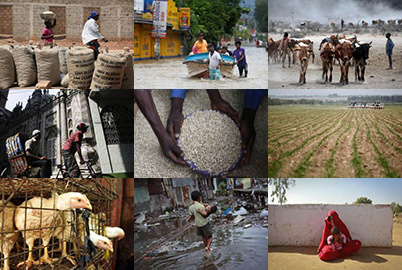Last May, the Red Cross office for West and Central Africa decided it wasn't going to let the flood disaster of 2007 happen again. The floods had affected over 800,000 people when torrential rains pummelled the region, destroying crops and homes.
Red Cross partner, the African Centre of Meteorological Applications for Development, and other forecasters issued warnings for abnormally heavy rains during the 2008 wet season. Acting on their advice, the aid agency decided to issue an early appeal for funds to help countries prepare, including stocking up on relief supplies in major cities.
Yet such cases of collaboration remain relatively rare. At a recent seminar bringing climate scientists and aid workers together in London, organised by the Humanitarian Futures Programme, a research initiative based at King's College that helps aid agencies tackle major challenges to their work, participants agreed they didn't communicate enough.
"We don't really talk directly to humanitarian groups, although we do to some development groups," admitted Richard Jones, manager of regional predictions at the Met Office Hadley Centre.
Andy Morse of Liverpool University urged aid agencies to get more involved in international discussions. "The humanitarian community...needs better representation. You need to keep bashing away at the climate scientists," he said.
WRONG TIME, WRONG PLACE
One major problem is that scientists tend to focus on how the climate will change in 20 to 100 years' time, whereas humanitarian workers want nearer-term forecasts for their planning - ranging from this week's weather to the next wet or dry season, and up to around five years ahead.
Declan Conway, a lecturer at the University of East Anglia, said a study he'd worked on in Ethiopia, exploring how climate change would affect development projects, had got a disappointing reaction from donors probably because of its 2020-2050 time scale.
Fortunately, according to Liverpool University's Morse, this mismatch of time horizons should be fixed in the next few years as more money is made available to fund shorter-term forecasting.
But it's not just a matter of time. Another complaint from aid agencies is that forecasts aren't available on a small enough geographical scale to be useful in the field.
Mark New, a climate scientist at Oxford University, has produced a set of national climate data summaries for 52 developing countries, funded by the United Nations Development Programme (UNDP) and the British government. These outline changes in temperature and rainfall since the 1960s and give an overview of what may happen as far forward as 2090.
"I know these projections are too coarse a resolution (for humanitarians), and I don't recommend that they should be used for very local assessments," New noted.
INFORMATION NOT DATA
On the positive side, the country profiles do marshal complex sets of statistics and probabilities into a few pages of fairly comprehensible text. The need to turn more climate data into information that can be used by non-specialists was a recurring theme at the seminar.
"It's not that there aren't enough climate models being run," said the Hadley Centre's Jones. "But not enough work has been done to interpret the information that comes out of the climate models."
He also stressed the importance of understanding the reliability of data and the context in which it should be used.
Both sides agreed there was a need for a deeper understanding of exactly what kind of climate information matters to aid workers.
"The communities we work with need reliable predictions on specific conditions," explained Jose Luis Penya, a risk reduction and livelihoods officer with Christian Aid. "The attention span of the farmers is five years, 10 years - no more - and they are interested in shifting patterns of rain."
COME RAIN OR SHINE?
This highlights another difficulty with climate predictions - also clear from the Oxford/UNDP profiles - that forecasts for temperature changes are much more certain than those for precipitation. Information on rainfall often includes such wide variations as to be practically useless.
This is unlikely to improve any time soon, according to East Anglia University's Conway. "We have much lower confidence about precipitation," he said. "And it will be another five to 10 years before we can give information with confidence about how extreme events will change in the future."
Mike Edwards, climate change advisor at CAFOD, suggested the best course for aid agencies would be to improve their capacity to manage risk. "We would all love to have regional and local predictions that are certain, but they're not available and I don't think they will be in the near future on a scale we can use," he said.
Yvan Biot, climate change policy advisor to Britain's Department of International Development (DfID), asked whether a better understanding of existing resilience to disasters like flooding might be more useful for aid agencies than detailed information about future climate trends.
Analysing vulnerability to today's climate hazards could serve as a basis for developing "low-regrets" measures that would help communities adapt to climate change both now and in the longer-term, he argued.
Other practical suggestions to boost the use of climate science in aid work included:
Yet amid all the enthusiasm for greater collaboration, aid agencies were also keen to remind their scientific colleagues that climate change is only one factor they must grapple with. And in the heat of an emergency it can slip down the agenda fast.
"We need to ask how important climate change is compared with other hazards like conflict," argued CAFOD's Edwards. "It's like going in to eastern Congo and Gaza and saying 'how about climate change?'".
Our Standards: The Thomson Reuters Trust Principles.

